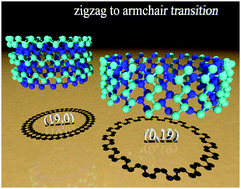Structural transition induced by compression and stretching of puckered arsenene nanotubes†
Abstract
The stretching and compression effects on puckered arsenene nanotubes (AsNTs) are investigated by using density functional calculations. The atomic arrangement determines the nanotube properties and relative stability; therefore, zigzag, chiral, and armchair present different properties. Since the AsNT properties depend on the diameter, three cases are considered: (a) (0, 9) and (9, 0), (b) (0, 14) and (14, 0), and (c) (0, 19) and (19, 0) NTs. For all calculated parameters of the smallest NTs, it is found that the armchair (0, 9) nanotube is always more stable than the zigzag (9, 0) nanotube. On the other hand, for the two largest NTs, a structural transition from armchair to zigzag is found upon stretching. Phase transitions are of great interest, in part because they result in changes of the properties of the material under study, changes that can be used in many technologies. To our knowledge, this is the first time that a structural transition in a puckered nanotube has been predicted. Our results show that the electronic band gap of the AsNTs can be modulated by increasing or decreasing the axial lattice parameter. It is also found that semiconductor NTs are more stable than metallic NTs.

- This article is part of the themed collection: Celebrating recent chemical science in Mexico

 Please wait while we load your content...
Please wait while we load your content...